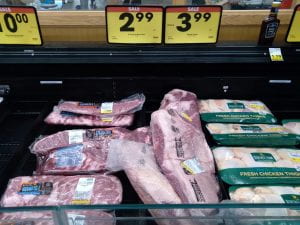By Glynn Tonsor, livestock and meat marketing specialist
 As society continues to transition from the pre-pandemic period and the many shocks that have occurred over the past couple years, it is easy to overlook a simple but critical fact – strong demand for U.S. beef has been supporting cattle prices! Published research points to cow-calf producers in particular accruing proportionally larger economic impacts from beef demand changes.[1] Accordingly, demand strength in recent years has supported feeder cattle prices and growing concerns in mid-2022 around beef demand strength are similarly worth monitoring, particularly for cow-calf producers. Given importance to producers, this short piece highlights recent beef demand patterns and resources of note.
As society continues to transition from the pre-pandemic period and the many shocks that have occurred over the past couple years, it is easy to overlook a simple but critical fact – strong demand for U.S. beef has been supporting cattle prices! Published research points to cow-calf producers in particular accruing proportionally larger economic impacts from beef demand changes.[1] Accordingly, demand strength in recent years has supported feeder cattle prices and growing concerns in mid-2022 around beef demand strength are similarly worth monitoring, particularly for cow-calf producers. Given importance to producers, this short piece highlights recent beef demand patterns and resources of note.
In a recent article with Jayson Lusk titled “U.S. Perspective: Meat Demand Outdoes Meat Avoidance” USDA data is used to document long-term trends in domestic meat consumption while Meat Demand Monitor (MDM) data is used to support a more recent, deeper assessment of contemporary meat demand patterns.[2] The MDM project, jointly supported by beef and pork checkoff programs, is informed by continuously tracking domestic consumer protein preferences and demand using nationally representative surveys completed each month since February 2020.[3] Consistent with the above-noted article’s title, meat demand in the U.S. has been strong corresponding with about ¾ of the population self-declaring to be regular meat consumers.
Over the past two years MDM data has provided refined insights such as ground beef demand adjusting more than ribeye steak demand in its retail (grocery) sector growth and food service (restaurant) sector decline during key COVID-19 epidemiological periods. Collectively across both domestic sectors and that of foreign demand for U.S. beef, strong consumer demand has supported higher cattle prices than we otherwise would have seen.
For a more recent assessment as consumers adapt to changing macro-economic conditions and society-wide inflation, consider the May 2022 MDM report. Domestic beef demand in May declined from April levels in both retail (grocery-store) and food service (restaurant) sectors. Over two-thirds of consumers indicate changing behavior given higher retail meat prices. The most common adjustment is buying a lower volume of desired products rather than changing brand, package size, or product cut.
Given the well-documented economic impact of consumer meat demand on the well-being of cattle producers, producers interested in updates to the domestic demand situation are encouraged to regularly visit the AgManager.info website to utilize resources including the latest outputs from the Meat Demand Monitor project.
[1] See research by McKendree et al. https://onlinelibrary.wiley.com/doi/abs/10.1093/ajae/aaz034
[2] This paper published in Meat Science is available here: https://www.sciencedirect.com/science/article/pii/S0309174022001115
[3] MDM reports, raw data, links to general media use and academic publications are available on K-State’s AgManager.info website: https://www.agmanager.info/livestock-meat/meat-demand/monthly-meat-demand-monitor-survey-data
